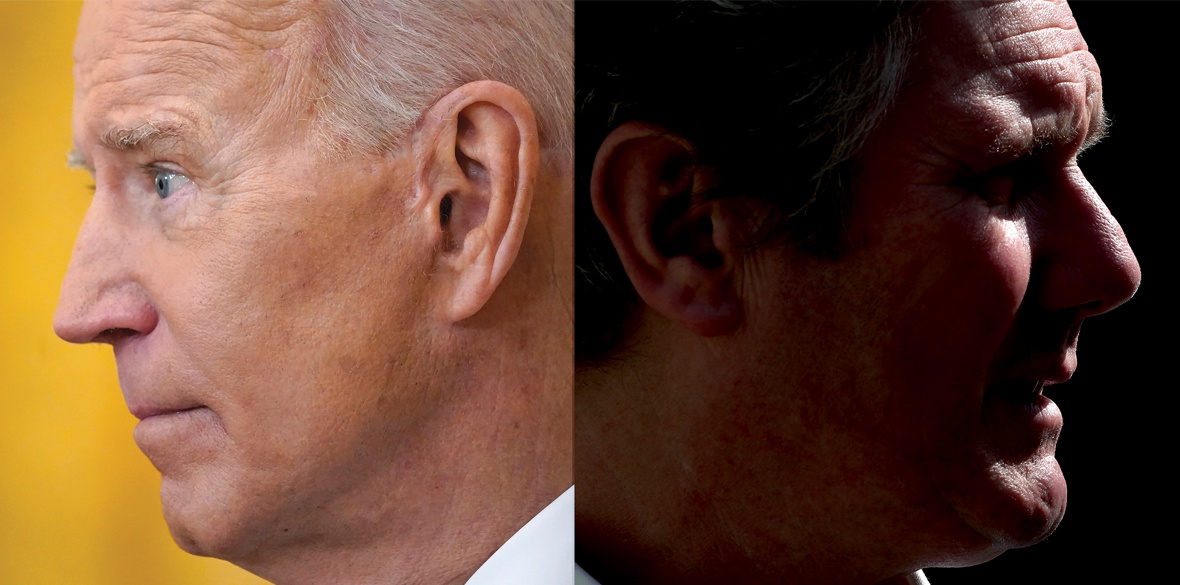This is the last article you can read this month
You can read more article this month
You can read more articles this month
Sorry your limit is up for this month
Reset on:
Please help support the Morning Star by subscribing here
EVEN Sir Keir Starmer’s supporters accept he is struggling to stand out against Boris Johnson and faces a difficult test at the local elections.
The reason is obvious — so obvious in fact that a lot of pundits have to try very hard not to see it.
Starmer and his team are putting all their effort into defining him against “Corbynism” instead of defining him against Boris Johnson.
They are fighting a negative little battle inside the Labour Party and losing a bigger battle with the Tories.
The more they fail to lay blows on Johnson, the more they overcompensate by lashing out against left-wing people or ideas.
If you look across to the United States to see what newly elected President Joe Biden is doing, it makes Starmer’s empty victory look all the more hollow.
The Democrats are historically to the right of Labour. Labour was founded with the trade unions as an explicitly socialist party of working people, while the Democrats merely have trade unions and the working class as a junior part of their coalition.
Consequently, Britain’s welfare state might be very ragged, but included a National Health Service, mass social housing and widespread benefit payments.
The US is still stuck on a restricted health insurance system, had limited housing “projects” and pays benefits in food stamps — or handouts of processed “government cheese” for the poor.
But Starmer’s determination to show he is a break with Labour’s left is putting him to the right of Biden.
Both Labour and the Democrats were shaken by insurgent movements from the left, which became much bigger and more popular than the “rules” of politics said they should.
Both Starmer and Biden won victories against this new left.
But Biden, realising the challenge from the left represented something quite powerful, decided to embrace the new forces as part of his coalition: Biden realised Donald Trump’s mix of hard-right and “populist” economic themes was hard to beat, and he needed all the help he could get.
So the left was brought in, albeit as junior partners. Biden adopted some Bernie Sanders policy proposals and put Bernie on the powerful Senate “budget committee.” Biden is also absorbing Elizabeth Warren’s staff.
By contrast, Starmer removed the whip from Jeremy Corbyn, sacked Rebecca Long Bailey, and seeks press approval with little performances designed to show breaks with the left.
By trying so hard to show his break from Labour’s left, Starmer misses the fight with the Conservatives in a way Biden does not.
Starmer’s nervous urge to be “different from Corbyn” over being “different from the Tories” leaves him on the wrong side of any inspiring reform agenda.
So in a convoluted attempt to prove Labour is “fiscally responsible,” Starmer pushed the party to oppose any increase in corporation tax.
This was more of an attempt to win the approval of the business and media Establishment than win over voters, as increasing tax on big business is not unpopular.
It was a botched job which gave the Tories room to manoeuvre on what should be firm Labour ground.
And it compares very badly with Biden: he has announced a $2 trillion stimulus plan, a programme of infrastructure investment, green jobs and welfare investment. Increasing business tax is part of the plan.
Starmer demanded the Tories say “No corporation tax rise” when the UK is on 19 per cent.
Biden is raising US corporation tax from 21 per cent to 28 per cent. Starmer’s nervous urge to be “not Corbyn” puts him way to the right of Biden.
Biden’s plan also involves a broadband investment not totally unlike Labour’s 2019 proposal.
Labour argued broadband wasn’t a luxury but an essential for small businesses and individuals, but despite public investment the telecoms firms were connecting too few people and charging too much.
Labour proposed nationalising the broadband infrastructure to lay more cable, and making broadband free.
The media attacked the proposal — the BBC called it “broadband communism.”
After the election, many Labour MPs accepted the caricature of the proposal as just “free stuff” and pushed to junk it — “soft left” and Labour right candidates, from Lisa Nandy to Jess Phillips, attacked the broadband plan after the election as “not believable” or not needed.
This is all about trying to show Labour is “responsible.” Labour’s broadband proposal actually had and still has majority support in polling, but Labour MPs trying to show they are “tough on spending” wanted to knock the policy.
This left Labour blindsided during the pandemic, which showed broadband was not a luxury: the Tory government started paying money to connect schoolkids to the internet, just after Labour’s leading MPs had abandoned their own internet investment policy.
Now Biden’s plan makes “responsible” Labour MPs look more out of touch.
Biden proposes putting $100bn public investment in broadband.
He isn’t proposing full nationalisation or free services, but he want more networks owned by local government, co-operatives and non-profits. Reducing the cost is key .
Biden said “millions of Americans lack access to reliable high-speed internet” so proposes funding so “every single American has access to high-quality, affordable, high-speed internet for businesses, for schools,” adding: “When I say ‘affordable,’ I mean it. Americans pay too much for internet service.
“We’re going to drive down the price for families who have service now, and make it easier for families who don’t have affordable service to be able to get it now.”
Biden argued “broadband is infrastructure,” not a luxury.
His plan calls broadband “the new electricity” — just as Franklin D Roosevelt’s New Deal brought electrification to rural America, Biden’s plan aims to wire up America with broadband.
Biden is a mainstream Democrat. He will do plenty that will disappoint or anger the left.
But he is trying to build a coalition that includes the left and presses for social reform and in some way addresses the future.
By contrast Starmer is trying to prove he is “respectable” by rerunning a stale old plan that focuses too much attacking Labour’s left rather than the Tories.
He is ritually sacrificing policies that Biden is embracing, and it’s not winning votes.
Biden’s example gives Labour a lot of space to revive a full plan of reform and redistribution, but it’s not clear that Starmer and his team can get into that space.












